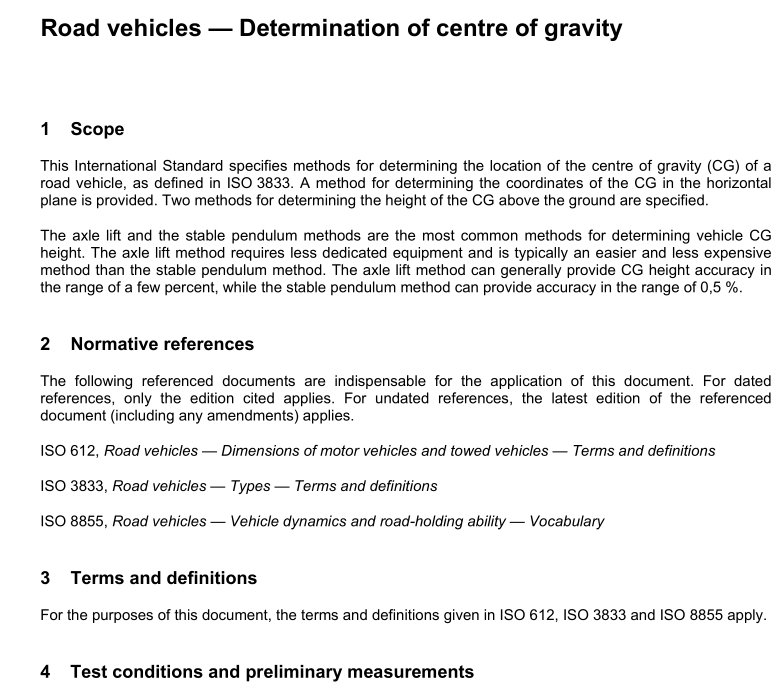ISO 10392 pdf download

ISO 10392 pdf download Road vehicles — Determination of centre of gravity
6.6 Data presentation
Measured data and test results shall be presented in a test report as shown in Annex A.
7 Determination of CG height: Stable pendulum method 7.1 General This section contains a detailed description of the stable pendulum method for determining vehicle CG height. Figure 2 is a diagram of the stable pendulum method for determining vehicle CG height. For the stable pendulum method, the CG of the combined vehicle and vehicle support platform system are below the pivot axis. This diagram shows the stable pendulum method in a pitch configuration, with a lateral pivot axis parallel to the road plane.
The stable pendulum method can also be configured in a roll configuration, with a longitudinal pivot axis parallel to the road plane. The equations provided in this clause are derived from a static torque balance about the pivot axis. In this case, a static disturbance torque is applied to the system by hanging known masses at a known distance from the pivot axis. A similar model and formulation of equilibrium equations can be used for the unstable pendulum method, except that the pivot axis is below the CG of the combined vehicle and vehicle platform system. For the unstable pendulum method, a static retarding torque is required to maintain the vehicle/platform system at any given tilt angle about the pivot axis.
In this case, force measurements, made using a scale or load cell placed at a known distance from the pivot axis, are used to determine the torque required to balance the system. Equations similar to those presented in this section, but with mathematical sign changes on some of the terms, can be derived for the unstable pendulum method. By using similar levels of accuracy for the required measurements and equipment specifications, the overall accuracy of the unstable pendulum method is similar to that of the stable pendulum method.
7.2Loading conditions, vehicle restraints, and mechanical parts
Any load shall be held in place to avoid displacement due to the inclination of the vehicle.
After loading the vehicle to the desired loading conditions, the vehicle shall be weighed and its total mass,my,recorded.The vehicle shall then be restrained to the pendulum platform in such a fashion as to minimizechassis motion relative to the platform. The total mass of the restraint components (shims,blocks, jacks,straps,etc.),mres, and the CG height of the restraint components’ mass,hres, shall be determined andrecorded.
When tilting the platform, the vehicle transmission shall be in the park position and the parking brake shall beapplied.The front wheels shall remain pointing straight ahead as much as possible.
For optimum accuracy, the pendulum platform should be as light and as rigid as possible.Also, the pivotbearings must have low friction and be precisely aligned.
The distance of pivot height above the platform (hpivot) and weight hanger locations ( and ha) must bemeasured precisely.
7.3 Measuring procedure
7.3.1 Position the loaded vehicle on the pendulum platform such that the vehicle/platform systemlongitudinal CG is located nearly directly below the pivot. The tilt angle of the platform with the restrainedvehicle secured to it should be less than 0,5 degrees to start the test.This is the angle with zero applied load,zERO-
7.3.2 The accuracy of the CG height calculation relies on making an accurate measurement of thelongitudinal motion of the vehicle relative to the platform, x. Mount a target to both sides of the vehicle. Usesuitable displacement transducers mounted rigidly to the platform to measure the longitudinal distances fromthe transducers to the targets. The average of the distances with zero applied load is XzERO
7.3.3 After recording zERo and x7ERo, apply a known mass, mg, near the fore end of the platform at knownlocation defined by l and hg(see Figure 2). The amount of applied load should be such as to cause theplatform to tilt no more than five degrees.Repeat with a different applied load to cause the platform to tilt to adifferent angle, but still no more than five degrees.Repeat this procedure for rearward tilt angles by applyingloads near the aft end of the platform.Record 0, x, and mg for all test conditions.









